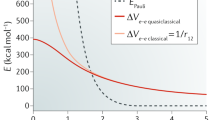Abstract
The elimination of a ligand pair from contiguous atoms in a molecule increases the bond order between them by unity as the remnant electrons rearrange into a suitable molecular orbital. Starting from experimental single-bond Morse curves, it is shown that screening of the internuclear repulsion by these electrons accounts for almost the total increase in bond strength during the formation of double and triple bonds. Reverse screening has a similar though smaller effect on adjacent single bonds, and observed trends can be accounted for adequately by the same mechanism.
Similar content being viewed by others
References
Benson, S. W. (1965)J. Chem. Educ. 42, 502.
Boeyens, J. C. A. (1980)S. Afr. J. Chem. 33, 14.
Kennard, O., Watson, D. G., Allen, F. H., Isaacs, N. W., Motherwell, W. D. S., Pettersen, R. C., and Town, W. G. (1972)Molecular Structures and Dimensions, Vol. 1A (Oosthoek Uitgevers, Utrecht).
Morse, P. M. (1929)Phys. Rev. 34, 57.
Shimanouchi, T. (1963)Pure Appl. Chem. 7, 131.
Shimanouchi, T. (1970) in,Physical Chemistry, An Advanced Treatise, Vol. IV, D. Henderson, ed. (Academic Press, New York), p. 233.
Author information
Authors and Affiliations
Rights and permissions
About this article
Cite this article
Boeyens, J.C.A. Multiple bonding as a screening phenomenon. Journal of Crystallographic and Spectroscopic Research 12, 245–254 (1982). https://doi.org/10.1007/BF01195716
Received:
Issue Date:
DOI: https://doi.org/10.1007/BF01195716




